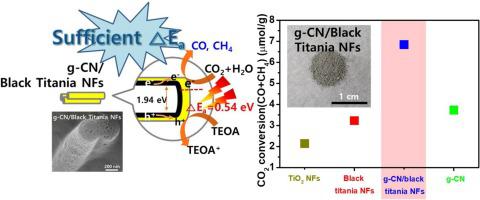Journal of CO2 Utilization ( IF 7.7 ) Pub Date : 2020-07-01 , DOI: 10.1016/j.jcou.2020.101230 Suhee Kang , Taehyeob Im , Minjeong Koh , Caroline Sunyong Lee

|
Black titania nanofibers (NFs) were electrospun and subjected to a simplified two-step sintering process at low pressure. Disordered “black” titania structures developed; Ti-O exhibited a blue shift and electrons occupied oxygen vacancies. Black titania NFs were coated with graphitic carbon nitride (g-C3N4) via sintering in an Ar atmosphere; the facile fabrication of metal-free heterostructures using non-toxic H2O reaction medium was reported to participate in photocatalytic CO2 reduction under UV–vis light irradiation, showing CO and CH4 yields of 5.19 and 1.65 μmol/g, respectively. The heterostructured g-C3N4/black titania NFs indicated 1.8-fold higher production of CO2 conversion (CO and CH4) compared to that of g-C3N4 while the heterostructure showed 2.12 times higher production of CO2 conversion (CO and CH4) compared to that of black titania NFs. Finally, the reusability test of the heterostructure was conducted upto the fourth cycle. Throughout the entire electronic band, heterostructured g-C3N4/black titania NFs exhibited increased absorption at 470 nm, even at the lowest photoluminescence intensity compared to that of g-C3N4. The calculated Fermi level and conduction/valence bands showed that the heterostructured g-C3N4/ black titania NFs exhibited proper band position associated with a sufficient kinetic overpotential of (△Ea,CH4) 0.54 eV, for successful production of both CO and CH4. This confirms that g-C3N4 and black titania NFs were well-connected via their interfaces so that this metal-free heterostructured g-C3N4/black titania NFs has proven its possibility to yield its CO2 conversion products.
中文翻译:

石墨氮化碳修饰的电纺黑二氧化钛纳米纤维的制备及其在光催化CO 2还原中的应用
黑色二氧化钛纳米纤维(NFs)进行静电纺丝,并在低压下经过简化的两步烧结工艺。出现了无序的“黑色”二氧化钛结构;Ti-O呈现蓝移,电子占据了氧空位。黑色二氧化钛NFs通过在Ar气氛中烧结涂覆了石墨氮化碳(gC 3 N 4);据报道,使用无毒的H 2 O反应介质轻松制造无金属的异质结构,可在紫外可见光照射下参与光催化CO 2的还原,显示出CO和CH 4的产率分别为5.19和1.65μmol/ g。异质结构的gC 3 N 4/黑色二氧化钛NFs表示,与gC 3 N 4相比,CO 2转化的产量(CO和CH 4)高1.8倍,而异质结构显示,CO 2转化(CO和CH 4)的产量高2.12倍。黑二氧化钛NFs。最后,对异质结构的可重用性测试一直进行到第四个周期。在整个电子带,异质结构的GC 3 Ñ 4 /二氧化钛黑色表现出的NF相比于GC的,即使在最低光致发光强度在470nm吸收增加,3 Ñ 4。计算出的费米能级和导带/价带显示,杂结构化的gC 3 N 4 /黑二氧化钛NFs具有适当的能带位置,具有足够的(△E a,CH4)0.54 eV动力学超电势,可以成功产生CO和CH 4。这证实了gC 3 N 4和黑二氧化钛NFs通过它们的界面连接良好,因此,这种无金属的异质结构的gC 3 N 4 /黑二氧化钛NFs已被证明可以产生其CO 2转化产物。



























 京公网安备 11010802027423号
京公网安备 11010802027423号